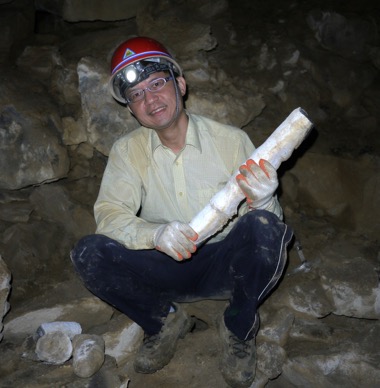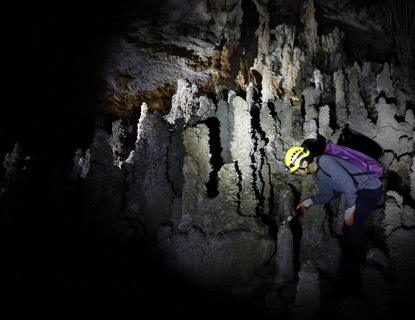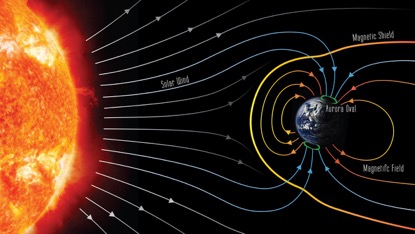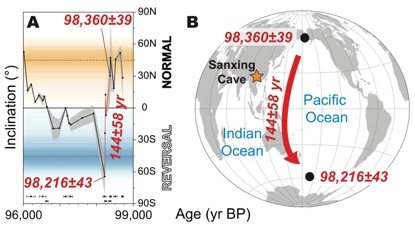Rapid geomagnetic oscillations and centennial polarity reversal events
Top geomagnetic breakthroughs by geological research team at National Taiwan University, directed by Dr. Chuan-Chou Shen, a Distinguished Professor at the Department of Geosciences, just published in the leading Journal "Proceedings of the National Academy of Sciences of the United States of America" on August 20.
The intensity of Earth’s magnetic field varies continuously and has decreased by 10-15% over the past century, which has led to suggestions of a possible impending reversal. However, no single reversal has been observed by humans in contemporary times. The transition time and detailed process of a reversal event have remained elusive even though that geomagnetic field had been well known over two thousand years and the geomagnetic reversals were discovered in igneous rocks a century ago. It is why Sciencemagazine listed it as one of 125 unsolved scientific questions in 2005.
Understanding the physical processes responsible for reversals has been hindered by the short timescale of modern observations and the intrinsic limitations of geological materials that are studied to learn about these processes. Stalagmites, used in our study, have proven to be highly suitable for paleomagnetic reconstructions because of their continuous formation and simple mechanism by which they record magnetic information. Recent developments in refined radioisotopic dating methods and high-sensitivity superconducting magnetometry add further to the advantage of stalagmites for such studies. However, the most difficult challenge is to find a suitable stalagmite carbonate with sufficient magnetic mineral contents for paleomagnetic analysis.
After searching for over a decade, Dr. Chuan-Chou Shen and his team found ideal stalagmite samples from southern China with trace amounts of magnetic minerals. Even so, the magnetic intensity in the studied stalagmite is one thousand-times less than in most igneous rocks. The team coupled the world-leading high-precision U-Th radioisotopic dating techniques with high-sensitivity paleomagnetic analysis and obtained 180 paleomagnetic data points with 70 age control points to build a robust 16,000-year record of geomagnetic field variations from 107 to 91 thousand years ago . In this multidecadally-resolved record, an abrupt centennial reversal transition, which occurred within a century, is revealed at 98,000 years ago. This change is more than 10 times more rapid than previous estimates for the fastest rate of change, and more than 30 times more rapid than the generally accepted duration for polarity transitions.
The unprecedented chronology precision provides an important step toward understanding processes that control polarity reversals, where the speed of reversal was not previously appreciated. This research is just the beginning. Future work on other stalagmite records shed further light on the nature of geomagnetic field variability and polarity reversals and excursions.
Human beings and our ancestors have lived on Earth for several millions of years. Many polarity reversals have occurred throughout this time, so reversals do not represent a challenge to our survival. However, polarity transitions can cause severe disordering of the ionosphere, atmosphere, and biosphere. Such abrupt events could have serious implications for animal navigation, radio communication, satellites, and electronic power systems. Infrastructure and facilities for communication and transportation are likely to be affected, which could include the global internet system and stock markets.
The full research article “Multidecadally resolved polarity oscillations during a geomagnetic excursion” will be available on http://www.pnas.org/content/early/2018/08/14/1720404115.
Media Contact:
Chuan-Chou Shen, Department of Geosciences, National Taiwan University, Taipei, Taiwan ROC. (currently visiting University of Oxford currently)
LINE: River SHEN; Skype: River SHEN; e-mail: This email address is being protected from spambots. You need JavaScript enabled to view it..
Image 1: Prof. Chuan-Chou Shen of the Department of Geosciences, National Taiwan Univerity, surveyed in cave. (Image courtesy of Chuan-Chou Shen)

Image 2: Stalagmites in southern China preserve detailed polarity oscillations and centennial reversal events. (Image courtesy of Chuan-Chou Shen)

Image 3: Geomagnetic field shields Earth from direct impact of solar wind and cosmic radiation. (Image courtesy of Yu-Min Chou)

Image 4: (A) Stalagmite-revealed unique oscillations of the geomagnetic pole on centennial-to-millennial scales. One surprisingly rapid reversal event occurred just around 144 years at 98 thousand year ago. (B) The calculated transition path of the geomagnetic pole during the reversal event from 98,360 to 98,216 years before present (yr BP). Star symbol denotes Sanxing Cave where the stalagmite was collected. (Image courtesy of Yu-Min Chou)

